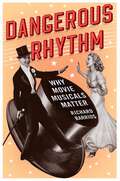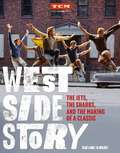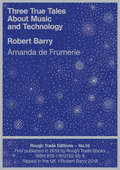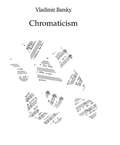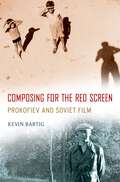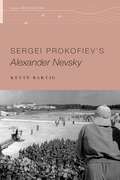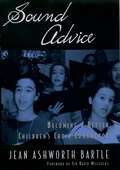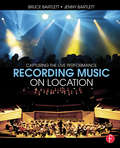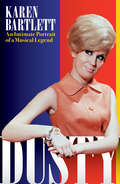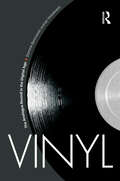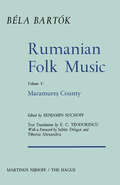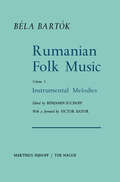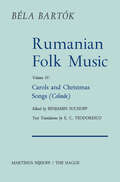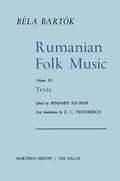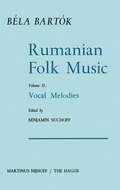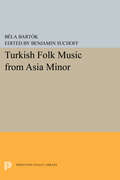- Table View
- List View
Integrated Team Working: Music Therapy as part of Transdisciplinary and Collaborative Approaches (PDF)
by Alison Barrington Ann Sloboda Ann Woodward Claire Miller Claire Molyneux Jackie Lindeck Julie Sutton Karen Twyford Maria Radoje Nicky O'Neill Paula Hedderly Rachel Darnley-Smith Rachel Millman Rebecca O'Connor Roseanne Tyas Sally Watson Tessa Watson Wendy MageeIntegrated Team Working describes collaborative multidisciplinary approaches and demonstrates that they can be valuable methods of music therapy intervention. The authors explain the development of the music therapist's role within the multidisciplinary team and discuss the prevalence of collaborative partnerships between UK music therapists and other professionals such as occupational therapists, speech and language therapists, psychologists, physiotherapists and other arts therapists. They examine the rationale, purpose and application of collaborative approaches and explore how and why music therapists adopt these approaches at differing levels. The book includes case studies from a variety of clinical settings, which illustrate the creative and innovative approaches used in transdisciplinary work in the evolving discipline of music therapy. This theoretical and practical guide offers useful advice for music therapy students and professionals who wish to employ collaborative approaches. It will also be helpful for other professionals who are considering or already working together with music therapists.
Dangerous Rhythm: Why Movie Musicals Matter
by Richard BarriosSingin' in the Rain, The Sound of Music, Camelot--love them or love to hate them, movie musicals have been a major part of all our lives. They're so glitzy and catchy that it seems impossible that they could have ever gone any other way. But the ease in which they unfold on the screen is deceptive. Dorothy's dream of finding a land "Somewhere Over the Rainbow" was nearly cut, and even a film as great as The Band Wagon was, at the time, a major flop. In Dangerous Rhythm: Why Movie Musicals Matter, award winning historian Richard Barrios explores movie musicals from those first hits, The Jazz Singer and Broadway Melody, to present-day Oscar winners Chicago and Les Misérables. History, film analysis, and a touch of backstage gossip combine to make Dangerous Rhythm a compelling look at musicals and the powerful, complex bond they forge with their audiences. Going behind the scenes, Barrios uncovers the rocky relationship between Broadway and Hollywood, the unpublicized off-camera struggles of directors, stars, and producers, and all the various ways by which some films became our most indelible cultural touchstones -- and others ended up as train wrecks. Not content to leave any format untouched, Barrios examines animated musicals and popular music with insight and enthusiasm. Cartoons have been intimately connected with musicals since Steamboat Willie. Disney's short Silly Symphonies grew into the instant classic Snow White, which paved the way for that modern masterpiece, South Park: Bigger, Longer, & Uncut. Without movie musicals, Barrios argues, MTV would have never existed. On the flip side, without MTV we might have been spared Evita. Informed, energetic, and humorous, Dangerous Rhythm is both an impressive piece of scholarship and a joy to read.
Dangerous Rhythm: Why Movie Musicals Matter
by Richard BarriosSingin' in the Rain, The Sound of Music, Camelot--love them or love to hate them, movie musicals have been a major part of all our lives. They're so glitzy and catchy that it seems impossible that they could have ever gone any other way. But the ease in which they unfold on the screen is deceptive. Dorothy's dream of finding a land "Somewhere Over the Rainbow" was nearly cut, and even a film as great as The Band Wagon was, at the time, a major flop. In Dangerous Rhythm: Why Movie Musicals Matter, award winning historian Richard Barrios explores movie musicals from those first hits, The Jazz Singer and Broadway Melody, to present-day Oscar winners Chicago and Les Misérables. History, film analysis, and a touch of backstage gossip combine to make Dangerous Rhythm a compelling look at musicals and the powerful, complex bond they forge with their audiences. Going behind the scenes, Barrios uncovers the rocky relationship between Broadway and Hollywood, the unpublicized off-camera struggles of directors, stars, and producers, and all the various ways by which some films became our most indelible cultural touchstones -- and others ended up as train wrecks. Not content to leave any format untouched, Barrios examines animated musicals and popular music with insight and enthusiasm. Cartoons have been intimately connected with musicals since Steamboat Willie. Disney's short Silly Symphonies grew into the instant classic Snow White, which paved the way for that modern masterpiece, South Park: Bigger, Longer, & Uncut. Without movie musicals, Barrios argues, MTV would have never existed. On the flip side, without MTV we might have been spared Evita. Informed, energetic, and humorous, Dangerous Rhythm is both an impressive piece of scholarship and a joy to read.
West Side Story: The Jets, the Sharks, and the Making of a Classic (Turner Classic Movies)
by Richard BarriosA captivating, richly illustrated full account of the making of the ground-breaking movie classic West Side Story (1961).A major hit on Broadway, on film West Side Story became immortal-a movie different from anything that had come before, but this cinematic victory came at a price. In this engrossing volume, film historian Richard Barrios recounts how the drama and rivalries seen onscreen played out to equal intensity behind-the-scenes, while still achieving extraordinary artistic feats.The making and impact of West Side Story has so far been recounted only in vestiges. In the pages of this book, the backstage tale comes to life along with insight on what has made the film a favorite across six decades: its brilliant use of dance as staged by erstwhile co-director Jerome Robbins; a meaningful story, as set to Leonard Bernstein and Stephen Sondheim's soundtrack; the performances of a youthful ensemble cast featuring Natalie Wood, Rita Moreno, George Chakiris, and more; a film with Shakespearean roots (Romeo and Juliet) that is simultaneously timeless and current. West Side Story was a triumph that appeared to be very much of its time; over the years it has shown itself to be eternal.
Three True Tales About Music and Technology (Rough Trade Edition)
by Robert BarryHave you heard the story about the android that took to the operatic stage of eighteenth century London? Of the inventor who used musical chords to power an engine and fire a canon? What about the composer who helped the most beautiful woman in the world build a missile guidance system? Three True Tales About Music and Technology re-imagines these episodes from the sometimes tumultuous history of interactions between the sonic arts and technoscience as a series of folk tales and fairy stories—that just so happen to be true.
Chromaticism
by Vladimir BarskyFirst Published in 1996. Routledge is an imprint of Taylor & Francis, an informa company.
Chromaticism (PDF)
by Vladimir BarskyFirst Published in 1996. Routledge is an imprint of Taylor & Francis, an informa company.
Composing for the Red Screen: Prokofiev and Soviet Film (Oxford Music / Media)
by Kevin BartigSound film captivated Sergey Prokofiev during the final two decades of his life: he considered composing for nearly two dozen pictures, eventually undertaking eight of them, all Soviet productions. Hollywood luminaries such as Gloria Swanson tempted him with commissions, and arguably more people heard his film music than his efforts in all other genres combined. Films for which Prokofiev composed, in particular those of Sergey Eisenstein, are now classics of world cinema. Drawing on newly available sources, Composing for the Red Screen examines - for the first time - the full extent of this prodigious cinematic career. Author Kevin Bartig examines how Prokofiev's film music derived from a self-imposed challenge: to compose "serious" music for a broad audience. The picture that emerges is of a composer seeking an individual film-music voice, shunning Hollywood models and objecting to his Soviet colleagues' ideologically expedient film songs. Looking at Prokofiev's film music as a whole - with well-known blockbusters like Alexander Nevsky considered alongside more obscure or aborted projects - reveals that there were multiple solutions to the challenge, each with varying degrees of success. Prokofiev carefully balanced his own populist agenda, the perceived aesthetic demands of the films themselves, and, later on, Soviet bureaucratic demands for accessibility.
Composing for the Red Screen: Prokofiev and Soviet Film (Oxford Music / Media)
by Kevin BartigSound film captivated Sergey Prokofiev during the final two decades of his life: he considered composing for nearly two dozen pictures, eventually undertaking eight of them, all Soviet productions. Hollywood luminaries such as Gloria Swanson tempted him with commissions, and arguably more people heard his film music than his efforts in all other genres combined. Films for which Prokofiev composed, in particular those of Sergey Eisenstein, are now classics of world cinema. Drawing on newly available sources, Composing for the Red Screen examines - for the first time - the full extent of this prodigious cinematic career. Author Kevin Bartig examines how Prokofiev's film music derived from a self-imposed challenge: to compose "serious" music for a broad audience. The picture that emerges is of a composer seeking an individual film-music voice, shunning Hollywood models and objecting to his Soviet colleagues' ideologically expedient film songs. Looking at Prokofiev's film music as a whole - with well-known blockbusters like Alexander Nevsky considered alongside more obscure or aborted projects - reveals that there were multiple solutions to the challenge, each with varying degrees of success. Prokofiev carefully balanced his own populist agenda, the perceived aesthetic demands of the films themselves, and, later on, Soviet bureaucratic demands for accessibility.
SERGEI PROKOFIEV'S ALEXAND NEVSKY OKS C (Oxford Keynotes)
by Kevin BartigAudiences have long enjoyed Sergei Prokofiev's musical score for Sergei Eisenstein's 1938 film Alexander Nevsky. The historical epic cast a thirteenth-century Russian victory over invading Teutonic Knights as an allegory of contemporary Soviet strength in the face of Nazi warmongering. Prokofiev's and Eisenstein's work proved an enormous success, both as a collaboration of two of the twentieth century's most prominent artists and as a means to bolster patriotism and national pride among Soviet audiences. Arranged as a cantata for concert performance, Prokofiev's music for Alexander Nevsky music proved malleable, its meaning reconfigured to suit different circumstances and times. Author Kevin Bartig draws on previously unexamined archival materials to follow Prokofiev's Alexander Nevsky from its inception through the present day. He considers the music's genesis as well as the surprisingly different ways it has engaged listeners over the past eighty years, from its beginnings as state propaganda in the 1930s to showpiece for high-fidelity recording in the 1950s to open-air concert favorite in the post-Soviet 1990s.
Sergei Prokofiev's Alexander Nevsky (Oxford Keynotes)
by Kevin BartigAudiences have long enjoyed Sergei Prokofiev's musical score for Sergei Eisenstein's 1938 film Alexander Nevsky. The historical epic cast a thirteenth-century Russian victory over invading Teutonic Knights as an allegory of contemporary Soviet strength in the face of Nazi warmongering. Prokofiev's and Eisenstein's work proved an enormous success, both as a collaboration of two of the twentieth century's most prominent artists and as a means to bolster patriotism and national pride among Soviet audiences. Arranged as a cantata for concert performance, Prokofiev's music for Alexander Nevsky music proved malleable, its meaning reconfigured to suit different circumstances and times. Author Kevin Bartig draws on previously unexamined archival materials to follow Prokofiev's Alexander Nevsky from its inception through the present day. He considers the music's genesis as well as the surprisingly different ways it has engaged listeners over the past eighty years, from its beginnings as state propaganda in the 1930s to showpiece for high-fidelity recording in the 1950s to open-air concert favorite in the post-Soviet 1990s.
Sound Advice: Becoming a Better Children's Choir Conductor
by Jean Ashworth BartleSound Advice is a valuable resource for college students, beginning teachers, and experienced conductors of children's choirs. It covers the vast array of skills needed by today's conductor and will benefit all choir directors who want their choirs to reach a higher level of artistry. This book will be useful on many levels: for the college student studying the child voice and elementary teaching methods; for the teacher beginning to direct choirs in schools, synagogues, churches and communities; for experienced children's choir directors who wish to know more about orchestral repertoire for treble voices, conducting an orchestra, and preparing a children's choir to sing a major work with a professional orchestra. The underlying educational philosophy is sound; the author sees development of musicianship through singing as the primary goal of a children's choir program. This philosophy differs dramatically from the traditional concept of the conductor as all-knowing and the singers as receptacles. An outstanding aspect of the book is how the author leads the reader to an understanding of how to teach musicianship. Developing literacy in the choral setting is a mysterious, amorphous process to many conductors, but the author clearly outlines this important process with practical suggestions, well-documented examples, and a clear reading style which will reach readers on many levels. The comprehensive repertoire, skill-building sheets, and programs for all types of children's choirs will provide teachers with immediate and highly valuable resources.
Sound Advice: Becoming a Better Children's Choir Conductor
by Jean Ashworth BartleSound Advice is a valuable resource for college students, beginning teachers, and experienced conductors of children's choirs. It covers the vast array of skills needed by today's conductor and will benefit all choir directors who want their choirs to reach a higher level of artistry. This book will be useful on many levels: for the college student studying the child voice and elementary teaching methods; for the teacher beginning to direct choirs in schools, synagogues, churches and communities; for experienced children's choir directors who wish to know more about orchestral repertoire for treble voices, conducting an orchestra, and preparing a children's choir to sing a major work with a professional orchestra. The underlying educational philosophy is sound; the author sees development of musicianship through singing as the primary goal of a children's choir program. This philosophy differs dramatically from the traditional concept of the conductor as all-knowing and the singers as receptacles. An outstanding aspect of the book is how the author leads the reader to an understanding of how to teach musicianship. Developing literacy in the choral setting is a mysterious, amorphous process to many conductors, but the author clearly outlines this important process with practical suggestions, well-documented examples, and a clear reading style which will reach readers on many levels. The comprehensive repertoire, skill-building sheets, and programs for all types of children's choirs will provide teachers with immediate and highly valuable resources.
Music, Health and Wellbeing: Exploring Music for Health Equity and Social Justice (PDF)
by Brydie-Leigh Bartleet Naomi Sunderland Natalie Lewandowski Dan BendrupsThis book explores the power music has to address health inequalities and the social determinants of health and wellbeing. It examines music participation as a determinant of wellbeing and as a transformative tool to impact on wider social, cultural and environmental conditions. Uniquely, in this volume health and wellbeing outcomes are conceptualised on a continuum, with potential effects identified in relation to individual participants, their communities but also society at large. While arts therapy approaches have a clear place in the text, the emphasis is on music making outside of clinical contexts and the broader roles musicians, music facilitators and educators can play in enhancing wellbeing in a range of settings beyond the therapy room. This innovative edited collection will be of great interest to scholars and practitioners of music, social services, medical humanities, education and the broader health field in the social and medical sciences.
Recording Music on Location: Capturing the Live Performance
by Bruce BartlettRecording Music on Location provides an exceptional collection of information regarding all aspects of recording outside of the studio. Featuring clear explanations on how to achieve professional results, this book is divided into two distinct sections: popular music and classical music. Whether you record in the local rock club, jazz café, or in an orchestra hall, Bartlett offers sage advice on each stage of the process of location recording. Packed with hints and tips, this book is a great reference for anyone planning to venture outside of the studio. Audio examples, tracking sheets, weblinks, and downloadable checklists are available on the companion website at www.focalpress.com/cw/bartlett. This edition has been thoroughly updated and includes new sections on iOS devices, USB thumb-drive recorders, and digital consoles with built-in recorders, along with updated specs on recording equipment, software, and hardware. This edition will also show you how to prepare recordings for the web and live audio streaming, and covers spectral analysis, noise reduction, and parallel compression. A new case study will go in depth on classical-music recording.
Recording Music on Location: Capturing the Live Performance
by Bruce BartlettRecording Music on Location provides an exceptional collection of information regarding all aspects of recording outside of the studio. Featuring clear explanations on how to achieve professional results, this book is divided into two distinct sections: popular music and classical music. Whether you record in the local rock club, jazz café, or in an orchestra hall, Bartlett offers sage advice on each stage of the process of location recording. Packed with hints and tips, this book is a great reference for anyone planning to venture outside of the studio. Audio examples, tracking sheets, weblinks, and downloadable checklists are available on the companion website at www.focalpress.com/cw/bartlett. This edition has been thoroughly updated and includes new sections on iOS devices, USB thumb-drive recorders, and digital consoles with built-in recorders, along with updated specs on recording equipment, software, and hardware. This edition will also show you how to prepare recordings for the web and live audio streaming, and covers spectral analysis, noise reduction, and parallel compression. A new case study will go in depth on classical-music recording.
Dusty: An Intimate Portrait of a Musical Legend
by Karen BartlettKnown the world over for her unique musical style, distinctive look and a voice that propelled her into the charts time and time again, Dusty Springfield was undoubtedly one of the biggest and brightest musical stars of the twentieth century. Never one to be shy of the spotlight, Dusty broke the mould as the first female entertainer to publicly admit she was bisexual, and was famously deported from South Africa for refusing to play to segregated audiences during apartheid in 1964, just a year after the launch of her solo career. Combining brand-new material, meticulous research and frank interviews with friends, lovers, employees and confidants, journalist Karen Bartlett reveals sensational new details about the soul diva's unconventional upbringing, tumultuous relationships and unbridled addictions, including a lifelong struggle to come to terms with her sexuality. Named one of the Sunday Times's best musical biographies of 2014, this is the intimate portrait of an immensely complicated and talented woman - the definitive account of one of music's most legendary figures.
Vinyl: The Analogue Record in the Digital Age
by Dominik Bartmanski Ian WoodwardRecent years have seen not just a revival, but a rebirth of the analogue record. More than merely a nostalgic craze, vinyl has become a cultural icon. As music consumption migrated to digital and online, this seemingly obsolete medium became the fastest-growing format in music sales. Whilst vinyl never ceased to be the favorite amongst many music lovers and DJs, from the late 1980s the recording industry regarded it as an outdated relic, consigned to dusty domestic corners and obscure record shops. So why is vinyl now experiencing a ‘rebirth of its cool’?Dominik Bartmanski and Ian Woodward explore this question by combining a cultural sociological approach with insights from material culture studies. Presenting vinyl as a multifaceted cultural object, they investigate the reasons behind its persistence within our technologically accelerated culture. Informed by media analysis, urban ethnography and the authors’ interviews with musicians, DJs, sound engineers, record store owners, collectors and cutting-edge label chiefs from a range of metropolitan centres renowned for thriving music scenes including London, New York, Tokyo, Melbourne, and especially Berlin, what emerges is a story of a modern icon.
Vinyl: The Analogue Record in the Digital Age
by Dominik Bartmanski Ian WoodwardRecent years have seen not just a revival, but a rebirth of the analogue record. More than merely a nostalgic craze, vinyl has become a cultural icon. As music consumption migrated to digital and online, this seemingly obsolete medium became the fastest-growing format in music sales. Whilst vinyl never ceased to be the favorite amongst many music lovers and DJs, from the late 1980s the recording industry regarded it as an outdated relic, consigned to dusty domestic corners and obscure record shops. So why is vinyl now experiencing a ‘rebirth of its cool’?Dominik Bartmanski and Ian Woodward explore this question by combining a cultural sociological approach with insights from material culture studies. Presenting vinyl as a multifaceted cultural object, they investigate the reasons behind its persistence within our technologically accelerated culture. Informed by media analysis, urban ethnography and the authors’ interviews with musicians, DJs, sound engineers, record store owners, collectors and cutting-edge label chiefs from a range of metropolitan centres renowned for thriving music scenes including London, New York, Tokyo, Melbourne, and especially Berlin, what emerges is a story of a modern icon.
Rumanian Folk Music: Instrumental Melodies (Bartok Archives Studies in Musicology #1)
by Bela Bartokn several of his writings on folk music Bela Bart6k recalls an incident I that happened to him in 1904 during a visit to a small village in Tran 1 syl vania. Quite by chance he heard there an eighteen-year-old Hun garian peasant girl singing Hungarian folk songs whose construction was 2 significantly different from the songs he had known until then. This experience appealed to his imagination far deeper than chance oc currences usually do. It sparked in him a creative fire that was there after to impart to his music certain characteristics that are recognizable today as indigenous to the Bart6kian style of composition. The inspirational value of the incident was rekindled by return trips to Transylvania. During these trips he was not merely listening. He began notating, melodies, building them into a coordinated collection. Soon Bart6k's itinerary took him into villages populated in checkered proximity by both Hungarians and Rumanians, thence into little communities where the population was exclusively Rumanian. There he discovered that their songs were much less, if at all, influenced by the urban civilization of Western Europe than those he had collected in Hungarian villages. In an interview he gave to a Transylvanian newspaper in 1922, Bart6k described the difference between the available Hungarian and Rumanian songs.
Rumanian Folk Music: Carols and Christmas Songs (Colinde) (Bartok Archives Studies in Musicology #4)
by Bela Bartokn the first volume of Rumanian Folk Music (Instrumental Melodies) I portions of Bela Bart6k's subsequently-discarded preface, concern ing the fate of his folklore publications, are presented in explanation of the editorial processes necessary for achieving the publication. 1 By way of introduction to this revised edition of a previous, although in complete, published version of the Rumanian Carols and Christmas Songs (Colinde), we refer again to the author's suppressed lines which pertain to this volume: The second publication by the same publisher was to include my collection of Rumanian Colindas (Winter-solstice songs). Their extremely interesting texts were supposed to appear in original as well as in English. After several years of delay, the translation to English prose was completed, one part in adequate archaic English, the rest (by someone else) in most unsuitable Kitchen-English. The publisher did not wish to change this, though. Result: I published the book at my own expense; however, only the musical part, because of lack of sufficient funds. The texts are still in manuscript, even today. 2 Our primary aim, therefore, has been to unite the Rumanian poetic texts and translations with the musical part, in one volume, as was the desire of the author.
Rumanian Folk Music: Texts (Bartok Archives Studies in Musicology #3)
by Bela BartokN January 30, 1944, Bela Bart6k, writing from Asheville, North O Carolina, where he had gone to regain his strength after a long period of ill-health in 1943, commented, Here I have started on a very interesting (and, as usual, lengthy) work, the kind I have never done before. Properly speaking, it is not a musical work: I am arranging and writing out fair copies of Rumanian folksong texts'! Although the date has not as yet been established, the first draft of the Rumanian folk texts as texts per se was written-if an apparent age of the MS. can be considered a clue-sometime before Bartok had emigrated to the United States in 1940. This draft (see description below) had been forwarded for etymological data, according to the non-Bart6kian autography appearing thereon. The identity of the informant or informants involved and the circumstances surrounding this matter remain unknown at the present writing. After Bart6k had made offset prints of the music examples of the 2 first two volumes of Rumanian F olk Music in 1940, the printed but incomplete draft of Vol. II (Vocal Melodies)-comprising 304 of the ultimate total of 659 pages-was sent to Nicholas Vama~escu, then di rector of "The Romanian Radio Hour" (Station W. ]. L. B. , Detroit, 3 Michigan), for correction of the texts, in April, 1941. 1 Letter to Joseph Szigeti, in Bartok Bela levelei (ed. Janos Demeny; Budapest: Miivelt Nep Konyvkiado, 1951), p. 184.
Rumanian Folk Music: Vocal Melodies (Bartok Archives Studies in Musicology #2)
by Bela Bartokhe editorial treatment of the second volume of Bela Bart6k's T Rumanian Folk Music is not dissimilar to that applied to Vol. I. The matter of poetic texts here, however, must allow for a sizeable increase in corrigenda and addenda. But first, let us delve into the source material upon which Vol. II is based. THE MANUSCRIPTS The various drafts of Vol. II fall into five basic categories of editorial process: music, texts, notes to the melodies (and texts), preface, and 1 miscellaneous reference material. M usic.-The first draft comprises field recording transcriptions, and notations made on the spot when recording was not possible. Bart6k left behind the bulk of this material when he emigrated to the United States in October, 1940 (The complete poetic text appears together with the music in each transcription).2 The second draft, uncorrected, comprises 304 pages printed by photo 3 offset process from master sheets. The third draft, reproduced from 667 pages of master sheets, is 1 All are contained in the New York Bartok Archives (hereinafter referred to as the BA) in envelopes designated by the author as Nos. 82-83, 85-86, 88, 90-97, 100, 102, and 106-107. See fn. 12 of the editorial Preface to Vol. I for the complete listing of the Rumanian folk' music MS.
Turkish Folk Music from Asia Minor
by Bela Bartok Benjamin SuchoffThis book is a substantial and thorough musicological analysis of Turkish folk music. It reproduces in facsimile Bartók's autograph record of eighty seven vocal and instrumental peasant melodies of the Yürük Tribes, a nomadic people in southern Anatolia. Bartók's introduction includes his annotations of the melodies, texts, and translations and establishes a connection between Old Hungarian and Old Turkish folk music.Begun in 1936 and completed in 1943, the work was Bartók's last major essay. The editor, Dr. Benjamin Suchoff, has provided an historical introduction and a chronology of the various manuscript versions. An afterword by Kurt Reinhard describes recent research in Turkish ethnomusicology and gives a contemporary assessment of Bartók's field work in Turkey. Appendices prepared by the editor include an index of themes compiled by computer.Originally published in 1976.The Princeton Legacy Library uses the latest print-on-demand technology to again make available previously out-of-print books from the distinguished backlist of Princeton University Press. These editions preserve the original texts of these important books while presenting them in durable paperback and hardcover editions. The goal of the Princeton Legacy Library is to vastly increase access to the rich scholarly heritage found in the thousands of books published by Princeton University Press since its founding in 1905.

